Mercedes-Benz SL
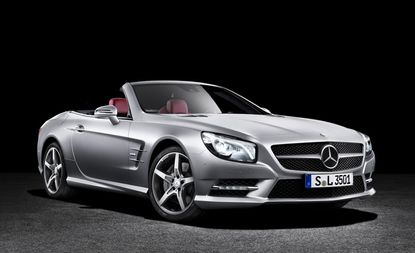
It's not easy describing modern cars without resorting to cliché or conjured-up fictions about their character and quality. So much of our perception of how a car looks and feels is shaped by carefully constructed marketing, leaving appraisals hopelessly muddied by the press briefing and brochure – not to mention the expansive hotel rooms, fine wines, blue skies and photogenic vistas. This shouldn't be surprising. Carmakers have been colouring the way we think about cars since the early days of the industry, framing their products in such a way that they cannot fail to go down a storm with their target market.
Few contemporary cars are a susceptible to this elaborate back-story as the Mercedes SL. The recently launched sixth-generation model can trace its ancestry back to the 1950s, and it is a glorious family tree (arguably its lineage goes back even further to the company's grand interwar grosser coupes, saloons and convertibles). Compact, relatively athletic and expertly engineered, the SL (standing for Sport Leicht) has always been one of Mercedes-Benz's 'halo products', an aspirational model inevitably pitched (and bought) by those who made it in life and felt like they should quietly reap the rewards.
The new car is more of the same. Like all big car-makers, Mercedes has a crowded portfolio and the days when the SL stood alone as the sole sporting offering have long gone. Today the SL is sandwiched between the junior SLK (originally launched in 1996 and now on its third generation) and the SLS AMG, a brilliant if rather awkwardly marketed 'supercar' – not to mention the myriad AMG-fettled saloons and coupes that exist across the range. Even so, the SL still carries with it the whiff of old money and good breeding, the faint suspicion that those who buy it do so regardless of what else is on offer because of what it is: a Mercedes-Benz. Are there any other cars?
Other manufacturers - be them Porsche, Maserati, Aston Martin, Jaguar and even BMW and Audi - make very worthy competitors, it's true. But without that three-pointed star on the bonnet they might as well be hawking wheelbarrows. A Mercedes buyer is loyal and true, if not necessarily the kind of ambassador for youth, vigour and forward-thinking innovation that all car companies must claim to be pursuing (and catching). The new SL is, to our eyes at least, better looking than its immediate few predecessors, blending Mercedes' current design language with a few design cues that hark back to the bulbous wings and lavish chrome of the 1950s. The long bonnet, snug cockpit and sleek roof profile are all pitch perfect, without resorting to showy design tricks and vulgar detailing (wait for the aftermarket companies to sort that out).
Sitting as it does at the upper end of the five-figure list price, the two-seater SL has always attracted stately wealth, those unconcerned with mere details like performance statistics. For those who care, the new SL's numbers are up while fuel consumption is down, thanks to the extensive adoption of aluminium in the body shell, a discrete stop-start system and other weight-saving gubbins. This car is as fast as you ever need it to be, even in the smaller-engined 350SL that wasn't available to sample in Spain.
These days if you pay over £75,000 for a car, the chances are it can bang on its 155mph speed limiter all day long without mishap - handy for short stretches of de-limited autobahn but almost entirely pointless anywhere else in the world. The accelerative shove is most welcome, although to treat this car like a ragged go-kart, blasting past everything in sight at every possible opportunity, is to rather miss the point of the long-legged grand-touring ethos. Nonetheless, there are bound to be those for whom the SL's ability around the bends and curves is going to fall a little short of a 'true' sports car.
Mercedes describes the SL as a car that can do everything, an everyday driver for the kind of person whose heart would palpitate at the thought of flying coach. In this respect, the SL is a form of insulation, a metal carapace that filters out life's little inconveniences and smoothes one's progress through an often unsympathetic landscape. Did we mention that two golf bags fit in the boot (with the metal hood raised)? About that boot: someone at head office has come up with yet another gadget, a sensor that detects a foot-waggling beneath the rear bumper and automatically opens the trunk in response. Mercedes goes one louder than similar systems by letting you shin-kick the boot shut again (although surely someone else should be carrying your bags at this point).
In order to cement this impression of effortless ability and aristocratic lineage, the company's Classic division laid on a fleet of old-school SLs, dating back from the 1950s right up to the 1990s. Mercedes' rolling archive probably amounts to several thousand vehicles, all sequestered away in vast underground vaults back in Germany. In recent years, many long-lived marques have taken to handing out well-preserved treasures from the vaults so that journalists can feel the march of technology at first hand while simultaneously being seduced by the tactile and aesthetic qualities of an earlier era. A 1958 300SL is very much a flag-bearer for a lost era, being both a symbol of Fifties glamour and the modern, wealthy collector. It's both a pleasure and privilege to burble along the dual carriageway that scythes through Marbella, soaking up jealous looks from the general population ensconced in their sterile modern cars.
There'll be hardcore SL63 and SL65 versions out later in the year for those who feel the performance (and status) of the SL is lacking. But we guarantee they'll mostly be bought for their flagship status and not the raw figures. The stock - if it can be described as such - SL is a hugely impressive car. Sure, if you're in the market for this car there's every chance you've owned an earlier model and your expectations are already high. But to those coming fresh to the SL experience, the new car will not disappoint.
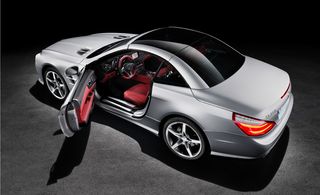
The new model is better looking than its immediate few predecessors, blending Mercedes' current design language with a few design cues that hark back to the bulbous wings and lavish chrome of its 1950s antecedents

Compact, relatively athletic and expertly engineered, the SL (standing for Sport Leicht) has always been one of Benz's 'halo products', an aspirational model inevitably bought by those who made it in life and feel like they should quietly reap the rewards
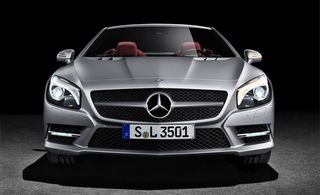
The accelerative shove is most welcome. Although to treat this car like a go-kart, blasting past everything in sight, is to rather miss the point of the long-legged grand-touring ethos
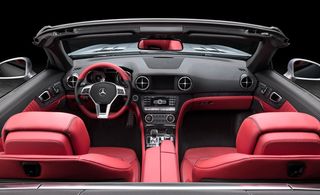
The SL is a form of insulation that filters out life's little inconveniences and smoothes one's progress through an often unsympathetic landscape. Did we mention that two golf bags fit in the boot (with the metal hood raised)?

A sensor in the boot detects a foot-waggling beneath the rear bumper and automatically opens the trunk in response. Mercedes goes one louder than similar systems by letting you shin-kick the boot shut again
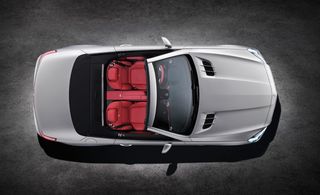
The long bonnet, snug cockpit and sleek roof profile are all pitch perfect, without resorting to showy design tricks and vulgar detailing
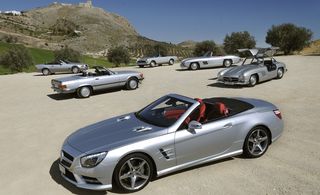
In order to cement this impression of effortless ability and aristocratic lineage, the company's Classic division laid on a fleet of old-school SLs, dating back from the 1950s right up to the 1990s
Wallpaper* Newsletter
Receive our daily digest of inspiration, escapism and design stories from around the world direct to your inbox
Jonathan Bell has written for Wallpaper* magazine since 1999, covering everything from architecture and transport design to books, tech and graphic design. He is now the magazine’s Transport and Technology Editor. Jonathan has written and edited 15 books, including Concept Car Design, 21st Century House, and The New Modern House. He is also the host of Wallpaper’s first podcast.
-
 David Lynch presents 'A Thinking Room' at the Salone del Mobile
David Lynch presents 'A Thinking Room' at the Salone del MobileHere's a first look at the David Lynch Salone del Mobile 2024 installation, a cinematic experience within the fair curated by Antonio Monda
By Laura May Todd Published
-
 Riva El-Iseo is the legendary boat builder’s first fully-electric motor yacht
Riva El-Iseo is the legendary boat builder’s first fully-electric motor yachtThe Riva El-Iseo electric speedboat blends classic Italian lines with a silent, powerful and zero-emission powertrain
By Jonathan Bell Published
-
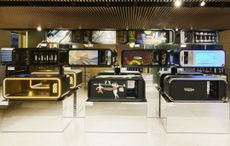 Technogym Home Bench 40 ways: designers interpret the home exercise classic
Technogym Home Bench 40 ways: designers interpret the home exercise classicTechnogym marks its 40 anniversary with 40 special editions of its Home Bench created in collaboration with international creatives
By Rosa Bertoli Published
-
 Peugeot’s sparky 308 gets hybrid power and handsome lines
Peugeot’s sparky 308 gets hybrid power and handsome linesThe Peugeot 308 proves that mass-market design needn’t be dull, blending hybrid power with sharp lines and excellent detailing
By Jonathan Bell Published
-
 BMW Motorrad brings out the big guns for its newest cruisers
BMW Motorrad brings out the big guns for its newest cruisersBMW Motorrad R 18 Bagger and Transcontinental set the tone for high-voltage cruising with a brand collaboration with speaker specialist Marshall
By George Chapman Last updated
-
 Dacia’s new Manifesto concept is a true outdoor utility vehicle
Dacia’s new Manifesto concept is a true outdoor utility vehicleUtilitarian auto brand Dacia sets a bold new agenda with its Manifesto, a concept car pitched at the active outdoor market
By Jonathan Bell Last updated
-
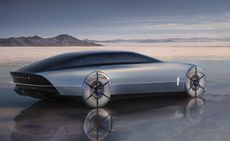 The sun sets on traditional supercars at California’s Monterey Car Week
The sun sets on traditional supercars at California’s Monterey Car WeekMonterey Car Week, the world’s most prestigious car gathering, is showcasing ever-more extravagant special editions, coachbuilt cars and all-new electric concepts. Here are seven key machines from 2022
By Rory FH Smith Last updated
-
 Is McLaren’s GT a sports car, a tourer, or the best of both?
Is McLaren’s GT a sports car, a tourer, or the best of both?The McLaren GT is a capable all-rounder dressed up in svelte supercar clothes. It might also be the last of its type
By Jonathan Bell Last updated
-
 Rolls-Royce puts the Phantom back on its lofty pedestal
Rolls-Royce puts the Phantom back on its lofty pedestalA mid-life refresh ensures the flagship Rolls-Royce Phantom Series II is at the top of its game, a last hurrah for traditional engines before an electrified future
By Jonathan Bell Published
-
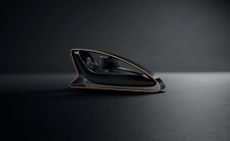 Prodrive’s new racing simulator is shaped by Callum to be front of the grid
Prodrive’s new racing simulator is shaped by Callum to be front of the gridThe racing simulator shapes up – this new design from Prodrive and Callum is honed for the high-end games room
By Jonathan Bell Last updated
-
 928 by Nardone Automotive: a restomod Porsche with Gallic verve and Italian style
928 by Nardone Automotive: a restomod Porsche with Gallic verve and Italian style928 by Nardone Automotive is a gracefully modernised version of Porsche’s endearingly different 928
By Jonathan Bell Last updated